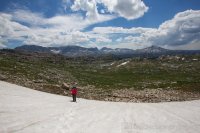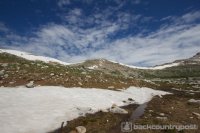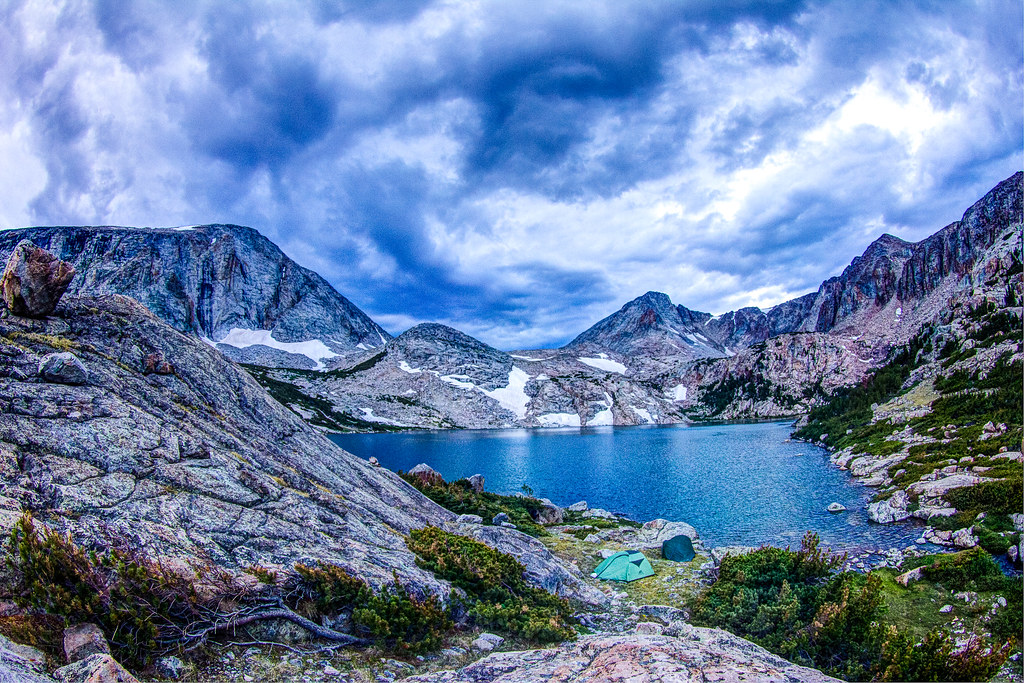- Joined
- Aug 9, 2007
- Messages
- 12,957
Just got back from a few days in The Wind Rivers. Full trip report to come but I wanted to post a quick note on conditions for anyone planning trips. We went in at Elkhart Park on July 5th 2012, up through Pole Creek Lakes to Cook Lakes, then over Lester Pass, down to the Seneca Lake Trail and back to Elkhart Park from there, 32 miles total.
The mosquitoes are out in force but from what I was told, they were actually lighter than average for this time of year in The Winds. I would give them a 7 on the scale of 1 being none and 10 being so damn many that I'm going home because of them. Don't screw around on the deet, bring the big aerosol can of 40%. We did the small aerosol of 25% and pretty much killed it by the 3rd day between two of us. I don't mess around with the 100% tiny bottles when they're going to be really bad.
There was a lot more snow than I expected to see. Mostly just random patches in the trees here and there that was not problematic. At the top of Lester Pass at 11,100 feet, there was still a very large drift which we were able to kick through. It was 100-150 yards and the thinnest point. See pic below.
Crowds were way lighter than I expected. The Pole Creek Trail parking lot at Elkhart Park was maybe 15-20% full and only saw a handful of people the rest of the time, one of which was Dan Ransom who just happened to setup camp a few hundred yards from us at Upper Cook Lake.
EDIT: Trip report is up, http://backcountrypost.com/forum/index.php?threads/cook-lakes-loop-wind-rivers.1042/
Here's a pic of my awesome wife audraiam crossing the snow on Lester Pass on 7/7/12

And a view looking up at Lester Pass from below as we came out of the Pole Creek drainage.

The mosquitoes are out in force but from what I was told, they were actually lighter than average for this time of year in The Winds. I would give them a 7 on the scale of 1 being none and 10 being so damn many that I'm going home because of them. Don't screw around on the deet, bring the big aerosol can of 40%. We did the small aerosol of 25% and pretty much killed it by the 3rd day between two of us. I don't mess around with the 100% tiny bottles when they're going to be really bad.
There was a lot more snow than I expected to see. Mostly just random patches in the trees here and there that was not problematic. At the top of Lester Pass at 11,100 feet, there was still a very large drift which we were able to kick through. It was 100-150 yards and the thinnest point. See pic below.
Crowds were way lighter than I expected. The Pole Creek Trail parking lot at Elkhart Park was maybe 15-20% full and only saw a handful of people the rest of the time, one of which was Dan Ransom who just happened to setup camp a few hundred yards from us at Upper Cook Lake.
EDIT: Trip report is up, http://backcountrypost.com/forum/index.php?threads/cook-lakes-loop-wind-rivers.1042/
Here's a pic of my awesome wife audraiam crossing the snow on Lester Pass on 7/7/12

And a view looking up at Lester Pass from below as we came out of the Pole Creek drainage.


